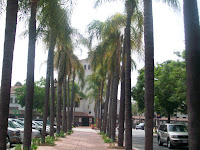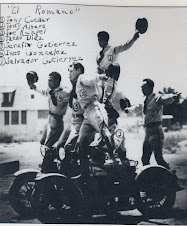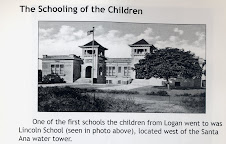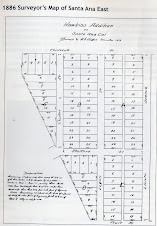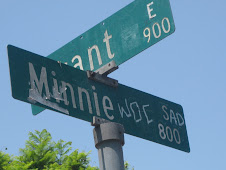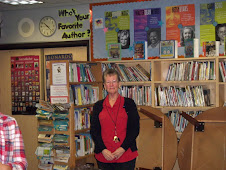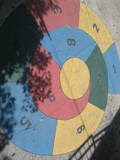

As our group started walking to the assigned neighborhood from our rendezvous point at the Santa Ana Regional Transportation Center, we began to notice a lot of new construction in the area – rows of buildings with stores at the ground level and lofts above. They seemed out of place here. The first question that came to mind was, “How are people in this neighborhood able to afford these lofts?” The answer, we
learned, is: They can’t.
The next structure that stood out to us was a huge water tower rising high above the neighborhood – a landmark residents could use to explain their 
relative location. As we continued down Stafford Street, we met an elderly couple, the Laras, who’ve lived in this neighborhood since the ‘50s. Mr. Lara was raised here and remembers when the tow yard on the corner was the site of the elementary school he attended.
Memorials and a community asset
Just a block farther on, we came to Logan Park, now called “Chepa’s Park.” At the front is a large monument erected in 2006 to commemorate the late Josephina “Chepa” Anderate. We learned from a plaster worker in the neighborhood that “Chepa” had been a dedicated advocate for the residents of the Logan Barrio, and in dedicating the park to her, Logan residents expressed their gratitude for someone who was willing to speak for them when no one else would listen.The neighborhood and the park at its center were named after John A. Logan, an Army General in the Civil War. Logan later graduated from law school and became an activist for veterans and public education. Streets in the Logan neighborhood also carry other generals’ names.
Local business
Down the street from Logan Park a landmark from 1950 still stands – the La Chiquita market and restaurant. It’s a small place, conveniently located at the corner of Washington and Custer. We could tell by the little group clustered outside, waiting for the store to open, that many local residents patronize the family-owned market.
The residents and business owners we spoke with all agreed that Logan has always been a Hispanic community. And while business owners seem to be Caucasians, there’s no hostility between the two cultures. Yet, there is a little resentment toward the city, for buying out homeowners and building industrial businesses smack in the middle of their neighborhood.
Where are the gangs?
We saw no gang members on our visit, but we learned that the “Logan Pluggers” used to run here. Now known as the “Logan Barrio,” they don’t actually live in the neighborhood, but they come here to play handball at the courts in Logan Park. From one source, we heard that the gang members normally don’t cause any problems. However, another resident painted a less benign picture of the gang – showing that, even among residents, people can see a community from completely different views.
A sense of community
As we continued our walk through the community, we began to understand that there’s a camaraderie among Logan residents. They look out for one another. Most of the homes we passed were older, with some new ones here and there. Except for some tagging on a wall of the park and on a few street signs, there was hardly any graffiti. There were few bars on windows, and the fences around the houses looked as though they could be there to keep children and dogs from wandering out on the street. We saw signs aimed at new home buyers, a “Do Not Enter” sign, some “Beware of Dogs” and a notice in Spanish advising solicitors that the Catholic occupants are not interested in materials from other denominations… which brings us to St. Joseph Church. This Catholic church is the only house of worship in the community.
From our perspective as Social Work students, we saw in the Logan Barrio a community of people who shared their Hispanic ethnicity and their Catholic faith; as well as their American patriotism – evidenced by military stickers, and by American flags waving proudly in the summer breeze.














